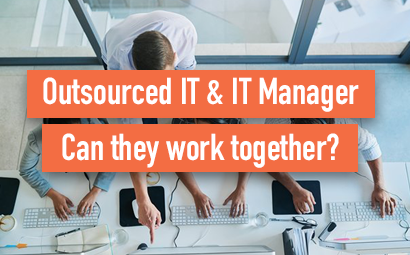
Depending on the size of your business, you may have (or be considering) a full in-house IT team, just a manager or even a member of staff who takes responsibility for IT along with their day to day role.
One of the advantages of having your own IT manager is that they understand the business requirements from being ‘on the ground’ and seeing first-hand what staff challenges and needs are.
They’re also just at the other end of the phone, so you know you can call them if you need them. However, if there’s just one person fulfilling those requests, they may find themselves inundated with problems they have to solve constantly, which takes up more of their time than is ideal.
Depending on how many teams there are within the business, and each team’s individual IT needs, an IT manager may require knowledge of a variety of software, hardware and network requirements. This is especially true if the business relies on cutting-edge technology.
One of the main reasons that companies are reluctant to have in-house help is that it can be expensive to have a full team, which is why the role often falls to just one person. It’s also time-consuming to train someone, and there’s always the risk of you being left without anyone who knows what they’re doing if that staff member decides to leave. If you'd like to find out more read our blog '10 reasons why you should consider external IT support'.
The Benefits of Outsourced IT Support
The biggest benefit of working with an outsourced IT support partner is that it’s usually cheaper, particularly if you choose break/fix only support. However, that’s not recommended as a solution, because you may find it a challenge to get someone to come out and make a repair.
 An external supplier will have greater capacity to give your organisation the right level of support, as well as having specialist knowledge of both the latest software and updates and any current threats to businesses.
An external supplier will have greater capacity to give your organisation the right level of support, as well as having specialist knowledge of both the latest software and updates and any current threats to businesses.
They will also be able to provide ongoing monitoring to identify problems before they happen, and depending on the package you choose, they should be able to provide 24-hour support.
An outsourced IT partner will be able to provide offsite or cloud storage and backup and will ensure that everything is up to date and secure. This saves office space and means data management isn’t the responsibility of one person within the business.
They can also look after email servers and reduce the risks of phishing and malware coming through to staff inboxes. And in the event of a disaster, they can work to restore everything while you focus on business as usual.
How the Two can Work Together
Having both internal and external IT support allows your IT manager to take a broader, holistic overview of the needs of the company, rather than having to resolve minor issues that can be fixed remotely.
 The IT manager should liaise with the outsourced partner to keep them up to date of any problems or challenges staff may be facing, and help the partner identify priorities.
The IT manager should liaise with the outsourced partner to keep them up to date of any problems or challenges staff may be facing, and help the partner identify priorities.
Ideally, the IT manager and outsourced support will share responsibilities. For example, you may choose to give the break/fix tasks to the IT manager onsite and use the partner organisation to help with more complex issues and to deal with data backup and disaster recovery.
In some situations, there may be compliance requirements for securing new contracts. Should you need particular certification or skills to partner with an organisation, if your IT support partner holds the qualification, that may be sufficient to meet requirements.
They may also be able to provide training or make a recommendation to a training company if required. Ultimately, the collaboration between the internal manager and external support will help your company run more efficiently
A hybrid model tends to be the option most businesses go for, and this is usually very successful. The key is to communicate openly, to discuss company needs and any changes to the IT infrastructure frequently and review both internal and external support at least annually.
For more information on working with an IT partner, download our IT Support: Essential Business Guide.



You must be logged in to post a comment.